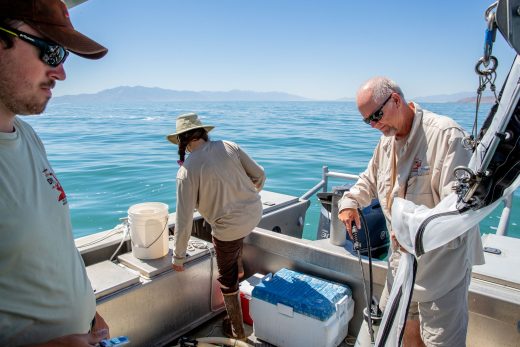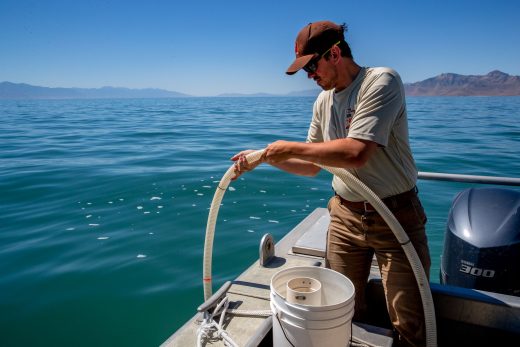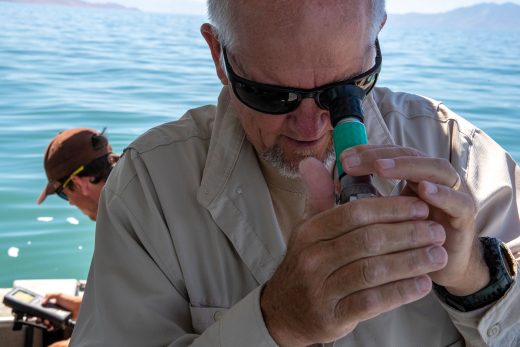Saving a Sea Monkey Sanctuary
As the Great Salt Lake in Utah shrinks, locals are working to preserve its critical brine shrimp fishery—along with the other entities that flourish in the lake’s strange, saline beauty.
Article body copy
Someone approaching the shores of Utah’s bleached-out and odiferous Great Salt Lake for the first time might be inclined to call it dead.
This is not the case.
Only half of it is at death’s door.
The other half could reach the threshold in the next decade.
I learn all this soon after boarding a research vessel at a marina, 30 or so kilometers from downtown Salt Lake City.
“Last year this was all dry,” says Jim Van Leeuwen, the Utah Division of Wildlife Resources biologist captaining the boat as he preps his gear under the shadow of a smoking minerals extraction plant. Joining us are two wildlife technicians: Danielle Aranda, who has gone back to school to get her master’s in natural resources, and Spencer Baxter, a younger first-year zoology student just dipping his toe into this super saline water. All of us are equally relieved and disturbed by this uncommonly warm day in November 2023. Relieved because we won’t have to sausage our way into skintight neoprene survival suits (the lake is so salty that winter water can reach a deadly -2 ˚C without freezing). Disturbed because it shouldn’t be so balmy. With more Novembers like this, fishing trips like the one we’re about to undertake may soon become a thing of the past.
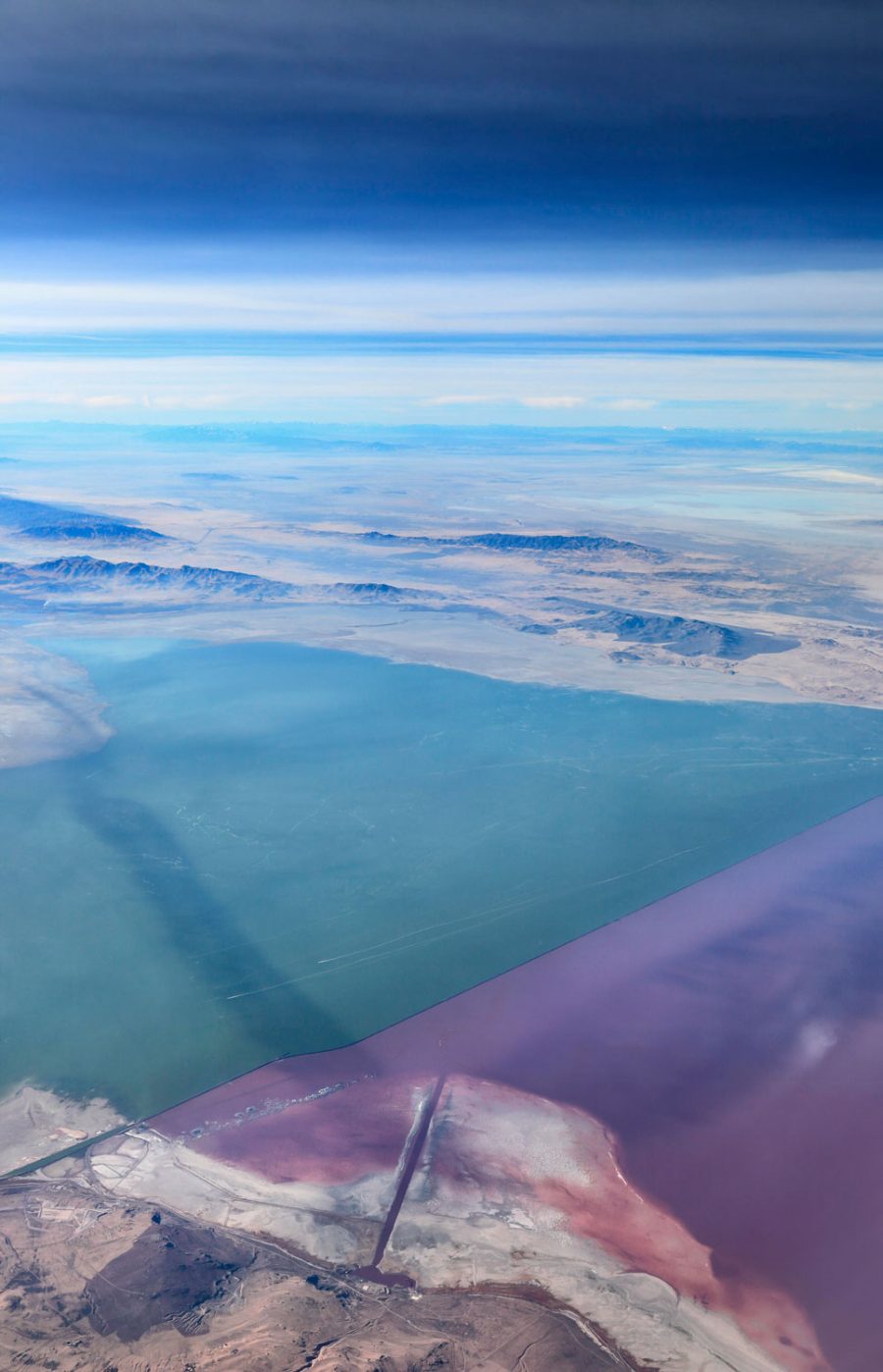
A causeway divides the northern and southern parts of Great Salt Lake, Utah. The red side is highly saline and “deadish” compared with the south side where Artemia are usually plentiful. Photo by dia karanouh/Alamy Stock Photo
Van Leeuwen eases his boat past the breakwater and out onto the smooth expanse of a lake that varies in size, depending on rainfall, from 2,500 to 6,200 square kilometers (somewhere between, say, Quebec’s Lake Mistassini and Saskatchewan’s Lake Reindeer). Today, it’s the size of Lake of the Woods, which straddles the borders between Manitoba, Ontario, and Minnesota, at 4,400. Last year, amid a 20-year drought, researchers from Brigham Young University in Provo, Utah, and other institutions forecast that the lake had only about five years left before it dried up altogether. That forecast came out while Utah was in the midst of a record-breaking season of snowfall—as much as 22 meters in the surrounding mountains. Feeder rivers rushed into this outlet-less “terminal basin” like the flow from a fully opened tap. The lake rose about 1.5 meters, which on this day gives Van Leeuwen the confidence to slowly open the engine and steer us north to a point marked on his survey map as sample site No. 4069. Still, he’s wary. Levels remain troublingly low and, with a salinity five times greater than the ocean, the lake macerates boat hulls and cuts the working life of outboard engines by at least a third if not half.
The extreme saltiness is also hard on aquatic life, which is why this isn’t exactly a “fishing” trip (there haven’t been any fish in Great Salt Lake in 14 millennia). But, as they say in Jurassic Park, “life finds a way.” The life that is here is worth tens of millions of dollars and represents a critical part of global food security.
Just past 10 a.m., Baxter drops anchor while Aranda unfurls a 2.5-meter-long sampling net, letting it dip below the surface. Then, in a motion meant to be precisely duplicated site by site, week by week, year by year, she draws it up smoothly and extracts a pink cloud of 1-centimeter-long wriggling creatures from the very much alive waters.
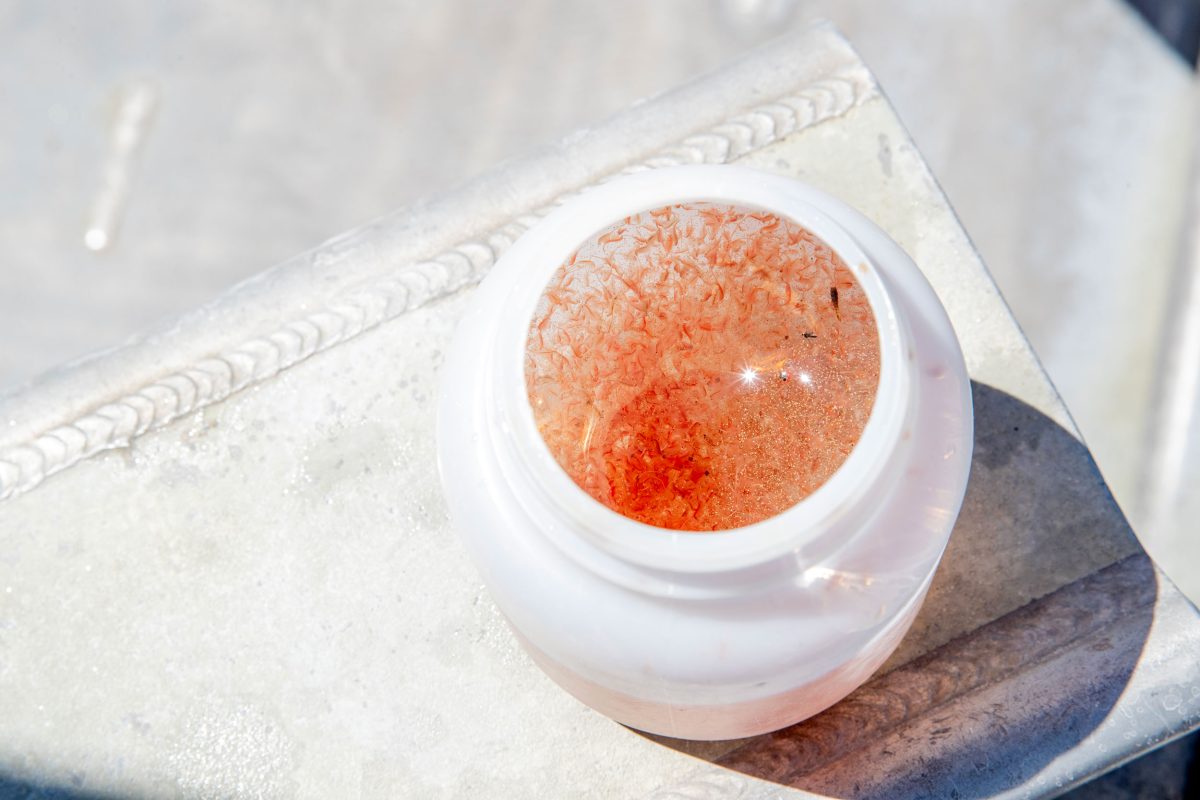
Artemia are sampled from Great Salt Lake to ascertain population levels. Photo courtesy of Utah Division of Wildlife Resources
“So many shrimpies!” Aranda exclaims.
“Depth?” Van Leeuwen calls out.
“3.8 meters,” she answers.
“Air temp?”
“11 ˚C.”
“Water?”
“10.4 ˚C”
“Salinity?”
“14.6 percent.”
“Well okay,” Van Leeuwen says. “Now we just have to do that 16 more times and we’re done.”
Scientists monitor the lake regularly to determine its health and the population of Artemia in any given year. Photos courtesy of Utah Division of Wildlife Resources
That Great Salt Lake had any life in it at all was first brought to my attention 15-odd years ago while working on a book about aquaculture. I was in a laboratory just outside Bergen, Norway, studying an early attempt to domesticate Atlantic cod. One of the researchers called me over to a beaker. There I watched a larval cod hunt down a pink vibrating insect-like creature and scarf it down whole.
“What’s it eating?” I asked.
“Artemia,” the researcher replied. “You call them brine shrimp, I think.”
“You grow those too?”
“No. They come from Great Salt Lake.”
“Huh,” I said. “I didn’t know Norway had a great salt lake.”
“No!” The researcher corrected me, “Your Great Salt Lake.”
Artemia provide a significant portion of feed to aquaculture facilities around the world. Video by BlackBoxGuild/Pond5
Beginning about 40 years ago, at the start of what food-systems types refer to as the Blue Revolution, marine scientists set out to take pressure off wild species by domesticating a select few. An early challenge was figuring out how to feed fish in their larval forms. At early stages of life, most ocean fish need living feed. Upon hatching, they have only rudimentary eyes and nostrils and can’t hunt by sight or smell. The only thing that triggers the feed response is the vibration that live prey register on a fish’s lateral line. In the wild, species of fish favored for human consumption, like branzino and cod, typically hatch a few weeks after the springtime bloom of zooplankton and have adapted to home in on a particular set of planktonic organisms called copepods.
In the 1960s, Japanese researchers led the charge on modern marine domestication with their most prized fish, red sea bream, called madai. To feed the baby bream, the researchers tried to mimic nature by growing copepods in the lab. But raising zooplankton is tricky. In open ocean ecosystems where salinity is a mere three percent, thousands of species of zooplankton are normally present; winnowing out and propagating a single desired strain are complicated and expensive procedures. This is where Artemia entered the picture. The Japanese researchers appeared to have gotten wind of an aquarium in San Francisco, California, that was using local brine shrimp to feed seahorses. Soon they found that the Great Salt Lake Artemia franciscana could be a much easier and cheaper alternative to growing copepods, thanks to the rather peculiar biology that make Artemia tick.
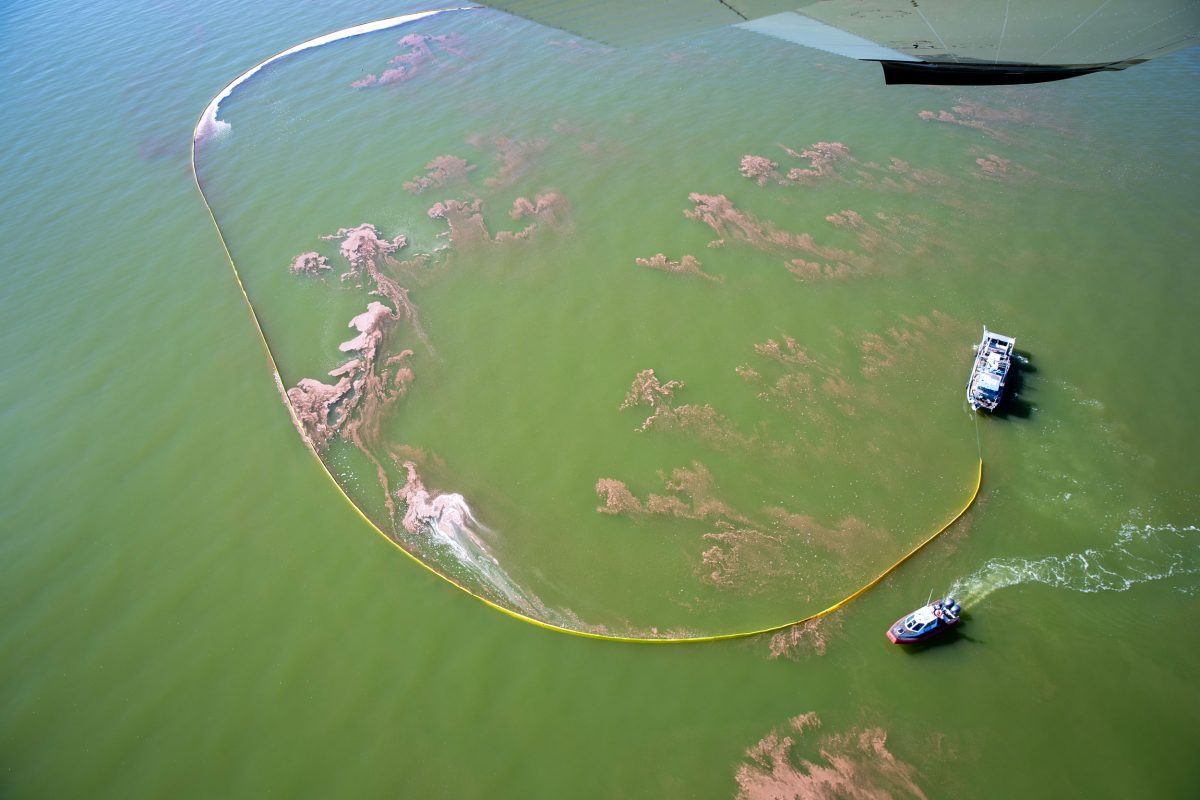
Alaskan fishers often take the opportunity to harvest Artemia from Great Salt Lake during their off-season. Photo courtesy of Utah Division of Wildlife Resources
Because Artemia are extremophiles, the expensive job of isolating a useful strain of zooplankton is no longer required; in harsh salt lake ecosystems, Artemia are the sole survivors. In addition, because salt lakes often go through periods when the conditions are too harsh even for Artemia to survive, these brine shrimp can put their embryos into a state of suspended animation called diapause. (Fun fact: a Chinese medical researcher recently sequenced the Artemia gene that prompts this temporary death and believes it has potential to put cancer cells into remission.)
But finding a cure for cancer is a side gig for Artemia.
Going back to their main hustle—what makes Artemia particularly useful in aquaculture is that after adults pause their embryos, they then “encyst” them in fantastically durable shells. Artemia cysts have been flown into the cosmos aboard U.S. and Soviet spacecraft and exposed to interplanetary solar radiation. They have been locked up in darkness for decades at a time. Still, they hatch. Pour them into a glass of salty water and expose them to light, and they reanimate, then grow to adulthood in just nine days.
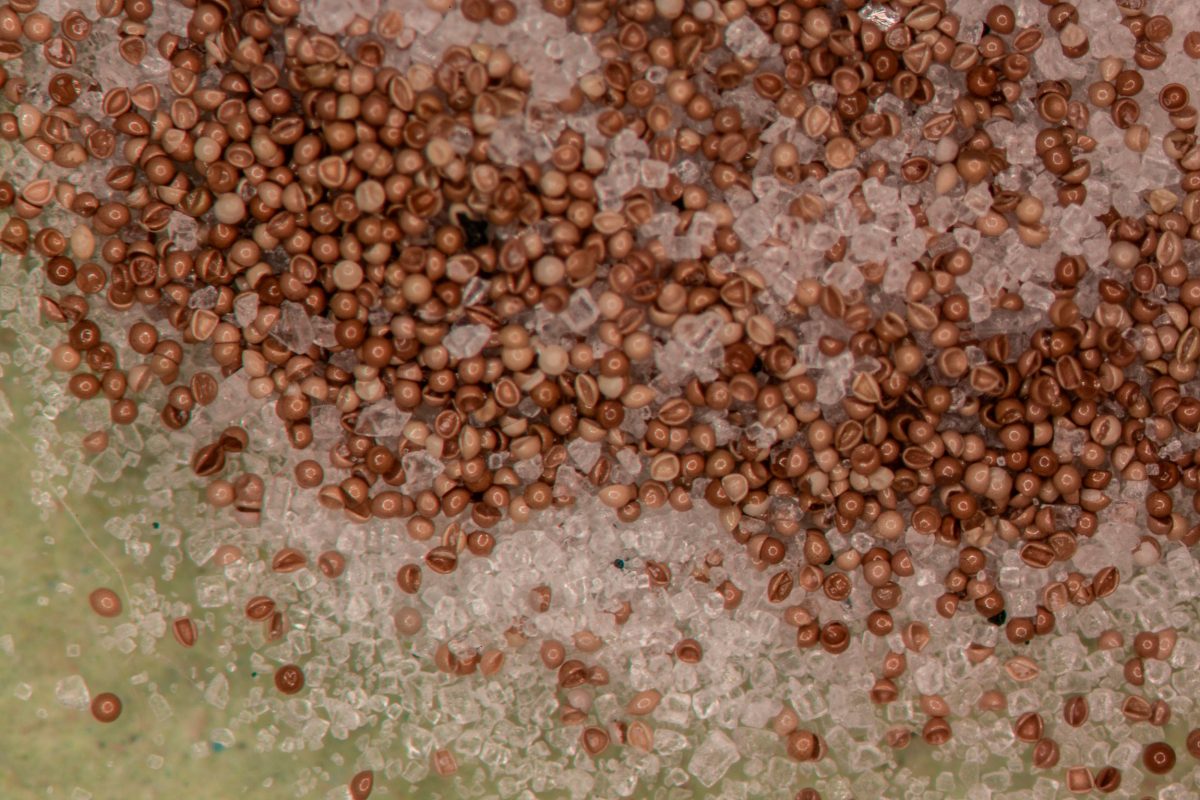
Companies that sell Artemia to the aquaculture industry ship the brine shrimp’s cysts. Add water and brine shrimp emerge from the egg cases. Photo by Dr. Norbert Lange/Alamy Stock Photo
If this sounds vaguely familiar, I’ll spill the beans on another Artemia side gig: they’re sea monkeys. The sea monkey gambit, though, was child’s play, concocted by a Jewish neo-Nazi who sold the cysts through ads he placed in the back of comic books in the 1960s and ’70s. (For more on that distracting and disturbing story, I direct you to Penny Lane’s documentary short Just Add Water.)
Today, Artemia’s more important and lucrative job is as the ideal industrial larval feed for marine fish around the world. Their cysts can be stored for years and then hatched at a predictable time; just add water and you’ve got the live food that larval fish need. They are also well suited for feeding white and tiger shrimp farmed largely in tropical regions around the world—North America’s most consumed seafoods. And yet, despite the critical role they play in global food production, the supply of wild Artemia remains limited.
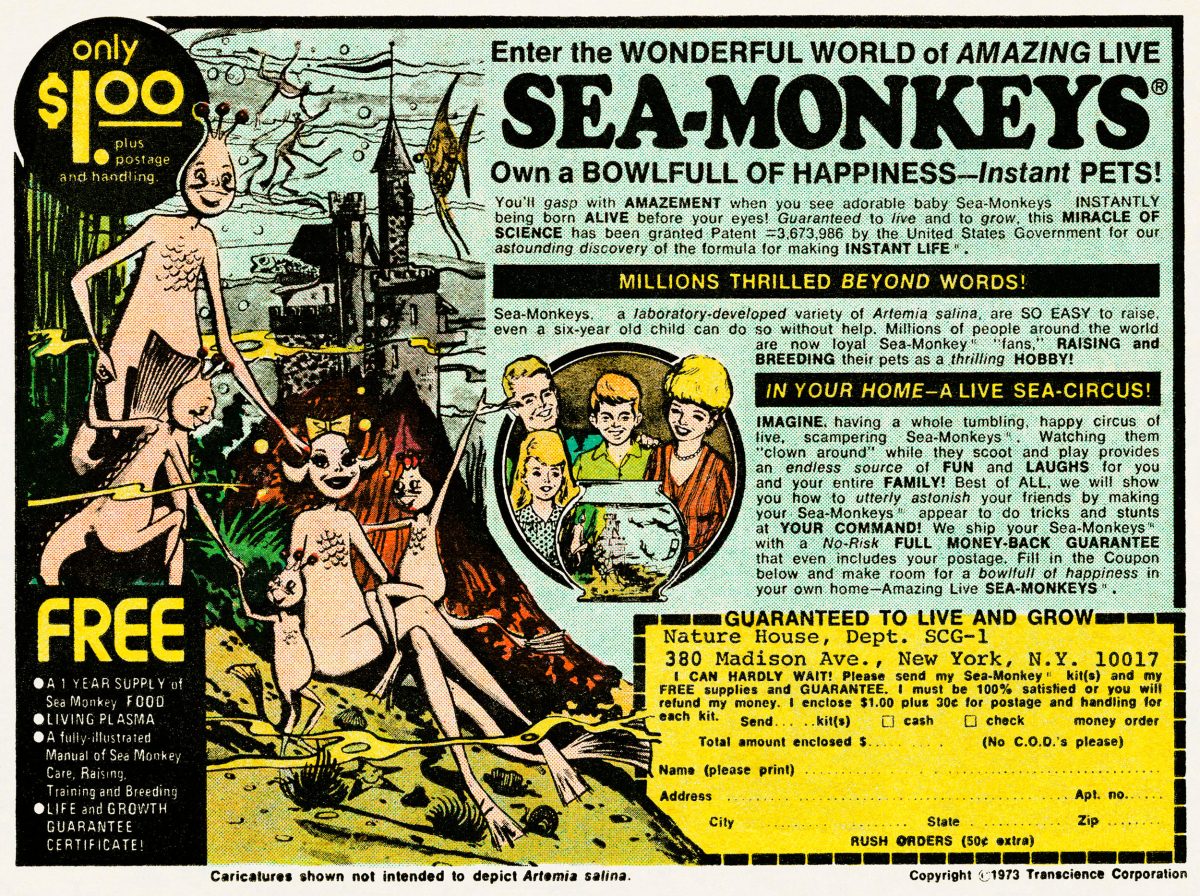
Decades ago, an entrepreneur with a sordid background began selling Artemia cysts to kids via comic books. Photo by M&N/Alamy Stock Photo
If Great Salt Lake were to disappear, an annual five million tonnes of farmed fish and shrimp could disappear with it. That’s roughly equal to the wild seafood the United States and Canada combined manage to catch in a year.
With our first brine shrimp secured, jarred, and labeled, Van Leeuwen turns our research boat northward and we continue to sample each predetermined site. Periodically, he points to a high ridge that follows a straight line dozens of meters above us. “You can see it right there,” he says. “That was the shoreline.”
That Great Salt Lake is disappearing is both a new and old phenomenon. In actuality, it’s been ratcheting down over more than a dozen millennia. Once upon a time, a massive lake 10 times the dimensions of the present body of water covered the region. Called Lake Bonneville by geologists, that ur-lake occupied about a quarter of the state. Bonneville’s sweet water was home to brawny cutthroat trout, while woolly mammoths grazed the shoreline. Somewhere around 20,000 years ago, though, a natural dam that separated the lake from the Snake and Columbia Rivers collapsed, and around 1,500 cubic kilometers of the lake drained away like water leaving a bathtub. Today, Great Salt Lake is the largest of several remaining salty puddles.
Van Leeuwen thinks a lot about that giant old lake. Once an avid trout fisherman, he surely fantasizes about what it would be like to cast for a Paleolithic trophy cutthroat. The sign-off on his emails quotes the Scottish novelist John Buchan: “The charm of fishing is that it is the pursuit of what is elusive but attainable, a perpetual series of occasions for hope.” Now, his only hope is a strain of trout that bears the ancient lake’s name. Puny “Bonneville” cutthroats still live in Great Salt Lake’s feeder streams. But in the extreme drought of the last two decades or so, those too are starting to wink out.
A small brine shrimp harvester putters in front of us, deploying the same sort of plastic boom used to clean oil spills. In this case, though, it’s harvesting wide pink streaks of Artemia cysts. The fisherman piloting this particular fishing boat has probably been directed to the plume by a spotter plane or a drone employed by the Artemia co-op that coordinates the fishery. He’s most likely one of several dozen Alaska salmon set netters who use the October to January Artemia opening as a kind of shoulder season. “They like the work,” Tim Hawkes, the self-described “sea monkey lawyer” who heads the Artemia co-op’s lobbying efforts, tells me later. “They can fish and ski and take it easy. We also level out the checks so they get paid regularly.” Both the state Department of Natural Resources and the Artemia co-op’s own scientists have reached a consensus that the fishery is healthiest if a minimum of 21 cysts per liter are present. Any less and the fishery gets shut down. That’s why Van Leeuwen and his crew are out on the lake this warm November day—making sure it’s neither overfished nor under fished: that sweet spot of 21 cysts per liter results in the optimal amount of hatching in the spring to come. So far, this stringent management pattern has maximized the Artemia population. The reward has been reliable jobs and income for humans and a productive ecosystem for animals that depend on the shrimp.
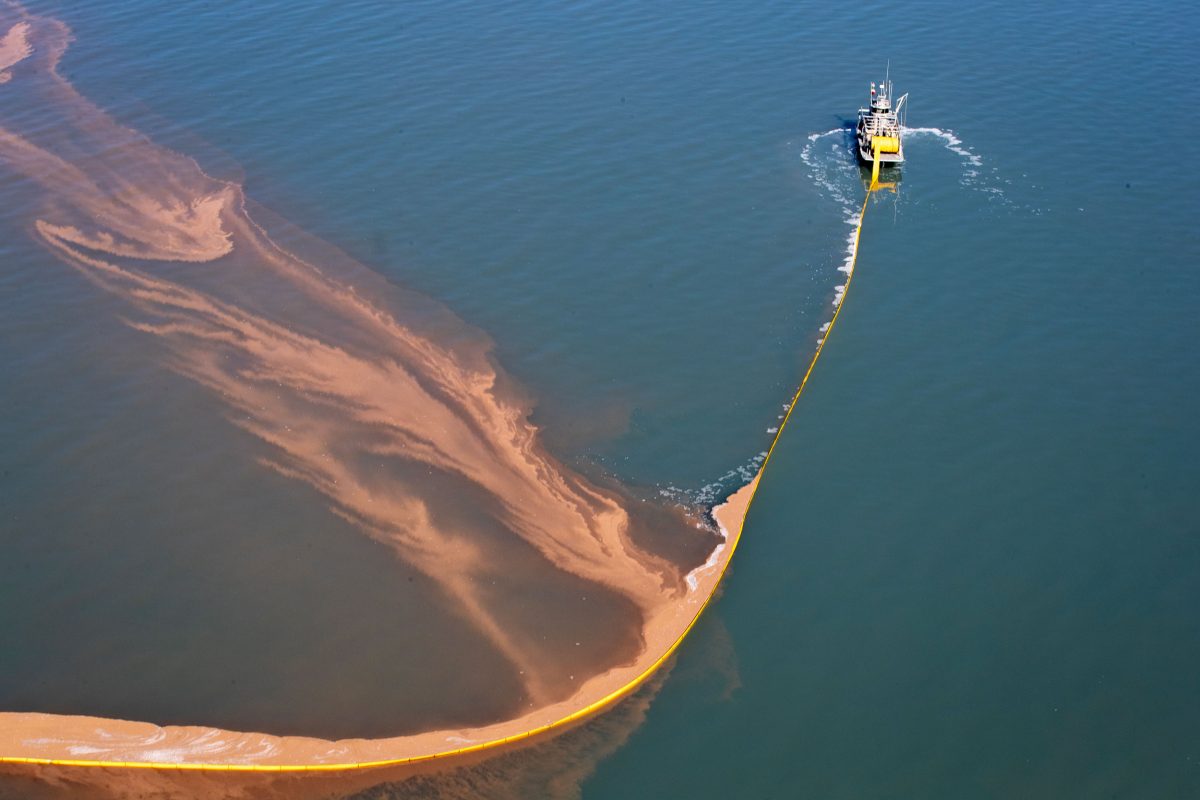
Over the years, between farming and development, less water has flowed into Great Salt Lake, which could eventually turn the whole lake into a high-salinity pond with habitat only suitable for certain bacteria. Photo courtesy of Utah Division of Wildlife Resources
But these pleasant, stable times are very much under threat—a threat that’s brought to mind by the visible haze spreading out from the city as we head toward the northern half of the lake. Post-COVID-19, greater Salt Lake City has become one of the fastest growing regions in the United States and is far cry from the Mormon shtetl most North Americans imagine. The lake-effect snow that helps give the region its legendary ski powder, a multitude of ethnic restaurants, an LGBTQ+ neighborhood, and groovy public art like a much loved rainbow humpback whale breaching in the middle of a traffic circle are among the things that have made it a cosmopolitan outdoors-forward city. As the lake recedes, the city’s demand for housing continues to grow with the expanding population. But all of these new people don’t seem to realize they are living in America’s third-driest state. Lush green lawns are standard, with watering levels beyond the natural rainfall in a tropical rainforest.
And that’s just a small part of the problem. A much larger part presents itself as one of the West’s seemingly endless freight trains chugging past us down the western shore.
“Whenever I see a train that long,” Van Leeuwen says, “I know it’s going far.” While we aren’t sure exactly what is on that particular train, it’s possibly carrying alfalfa, a dominant crop of the Salt Lake Basin. Used as feed for cattle and other livestock, this crop is sucking the area dry. Farmers of alfalfa and other forms of hay use over 60 percent of the water in this region. In a way, they’re indirectly exporting that water to Japan and China, which import something like 20 percent of the hay crop to feed cattle. It’s notable that Chinese consumers have increased their consumption of beef markedly in the last few decades.
So what will the lake look like if the many pressures on it are not eased? Soon we arrive at a vision of the future. Ahead of us, a railway trestle, built between 1902 and 1904 and hardened into an earthen causeway in 1953 called the Lucin Cutoff, effectively splits the lake in two. No major rivers enter it north of the divide. As a result, the water in the north half of the lake has a salinity of over 26 percent—approaching levels of the Middle East’s Dead Sea. It’s so salty that in the last two years, state officials have erected a stone barrier behind the causeway to stem the flow of hypersaline water into the lake’s healthy half. Meanwhile, the only thing living in this saltiest of environments are microorganisms, some of which are already stressed by the extreme saltiness and employ a red pigmented membrane shield to save their DNA from the sun’s ultraviolet light. These eerily red life forms make the water contrast dramatically with the blue-green waters to the south. The border between the two is straight as an arrow and as clear a signal of what humans can do to an ecosystem.
But if that stark division is unnerving, it is still less so than a lake that is entirely red and dead.
Authors of one scientific report worry that unless more water flows into the lake, it would become “red and dead” in five years. Video by BlackBoxGuild/Pond5
Like many environmental problems, Great Salt Lake’s disappearance has has one very simple solution—increasing the inflow from the basin’s feeder rivers. But there is a hornet’s nest of obstacles standing in the way of that solution. “Point blank: water is life,” Van Leeuwen says. Without more inflow, the lake will die. And therein lies the first obstacle: up until 2020, the lake had no legal right to its own water.
To a large degree, this dates back to the settlers’ very first impressions of the lake. A trapper and mountain man named Jim Bridger was the first white man to see it and declare it salty in 1824, though he admitted the salt it contained had its uses. When an extreme winter laid waste to a portion of the local buffalo population, Bridger boasted, “When spring came, all I had to do was to tumble ’em into the lake an’ I had enough pickled buffalo for myself an’ the whole Ute Nation for years.”
After Utah earned statehood, the office of the Utah State Engineer was created in 1903, and private citizens could apply for a share of the surface water that flowed from rivers to lake (ground water remained a free-for-all until 1934). In other drainages, where lakes are fresh and edible fish exist, lakes have at least a modicum of legal standing since they have a certain usefulness to humankind. Great Salt Lake, though, is last in line for its own water.
This willful ignorance of the lake’s importance has persisted well into the modern era. As Bonnie Baxter, the founding director of Westminster University’s Great Salt Lake Institute and one of the coauthors of the “dead in five years” Brigham Young University report on the lake, puts it, “When I got here basically you could propose any research topic on Great Salt Lake and you could be pretty well assured that it hadn’t been done before.” Today, research is slowly catching up and scientists have identified the lake’s role in the larger ecosystem, ranging from snowfall regulation to the feeding of one of the greatest animal migrations on earth. In lockstep with these discoveries, as both temperatures and populations rise, the conflict between humans and the lake has risen like underwater features appearing in a drought.
The agricultural community certainly is well aware that it, too, is part of the problem. One farmer who is particularly concerned is Joel Ferry, an alfalfa, corn, wheat, and beef producer whose family has for five generations held rights to the Bear River—the largest tributary to Great Salt Lake. In a weird twist of fate, Ferry is now also the executive director of Utah’s Department of Natural Resources (DNR) and as such the official most likely to get blamed if the lake goes dry. He takes this responsibility seriously, even if the long memory of his family knows that nature is fickle.

The Great Salt Lake as seen from the International Space Station. Photo by Science History Images/Alamy Stock Photo
“When I was a kid,” Ferry tells me, “we were in a ‘wet period,’ and the lake went right up to the edge of my farm. Everything was flooded.” Still, Ferry understands the dry-getting-drier condition of his homelands and recognizes that a farmer-first policy isn’t going to work as the present dry period settles into something permanent. In 2018, prior to becoming DNR executive director, Ferry was elected to the Utah House of Representatives where he teamed up with other legislators and Tim Hawkes, the aforementioned sea monkey lawyer from the brine shrimp co-op, and began taking on the state’s ossified water laws. Statute by statute they worked to get the lake the water it needed. Before they took action, water in Utah was a “use it or lose it” proposition. If you didn’t use your water for seven consecutive years, your rights went away. Ferry and Hawkes changed that. Under new regulations, farmers in any given year can dedicate their water rights to the lake without losing those rights in future seasons. This could help to more rationally manage the alfalfa crop, a perennial grass that is generally profitable in its first two seasonal cuttings, but not always worth the effort in for the third cutting And yet, farmers continued to do a third cutting, mostly because fallow fields are anathema to their idea of productivity and because of the erroneous fear that they would lose their water rights if they didn’t use their water for just one growing season. By creating a framework for farmers to get compensated for not doing a third cutting, Ferry believes producers might in the future “take one or two cuttings and fallow for the rest of the season, enabling water not used for crops to stay in the system or be dedicated to Great Salt Lake.”
These measures combined with some behavioral change could potentially moisten the lake’s future. One of their primary targets for such behavioral reform targets water usage, which Ferry and Hawkes have tracked. Water enters Utah homes along two streams: a drinkable one that is metered and a secondary water one for yard watering and agriculture that is unmetered. The cost of the water flowing down that secondary pipe is covered by a separate company and billed back to the customer at a flat rate. “You could use 10 gallons or a million gallons, and you still paid the same rate,” Hawkes says. Now, thanks to a new law, House Bill 242, that secondary water metering question is starting to be addressed by requiring individual water use to be published. Today, in Utah, if your neighbors have an emerald green lawn, you can see how many liters they used to make their backyard Oz.
But what if these mitigating measures don’t work and it just keeps getting hotter and hotter, and the city keeps getting bigger and bigger, and the lake still goes bust?
Well, things are getting both brighter and weirder for Artemia. Back in the first half of the 1990s, when Joel Ferry was a kid and just before the lake entered a wet period, Great Salt Lake produced 95 percent of the world’s brine shrimp. But when the floods came, the water turned fresh enough to allow Artemia predators into the lake to significantly stress the survivors. The harvest in 1997 and 1998 was significantly reduced, and in 1999 the fishery virtually collapsed. A global aquaculture panic ensued. Other countries with salt lakes saw an opening. Arsal, a Siberian company based in Yarovoye, Russia, began exploiting the brine shrimp that hatch out of saline Great Yarovoye Lake. China, too, got into the game. Even that famously human-killed lake, the Aral Sea straddling the border of Uzbekistan and Kazakhstan, is becoming a player, specifically the western portion. It turns out that when fishable lakes like the Aral die, sometimes they can be reincarnated as brine shrimp nurseries. Today non-U.S. sources account for more than half the Artemia market.
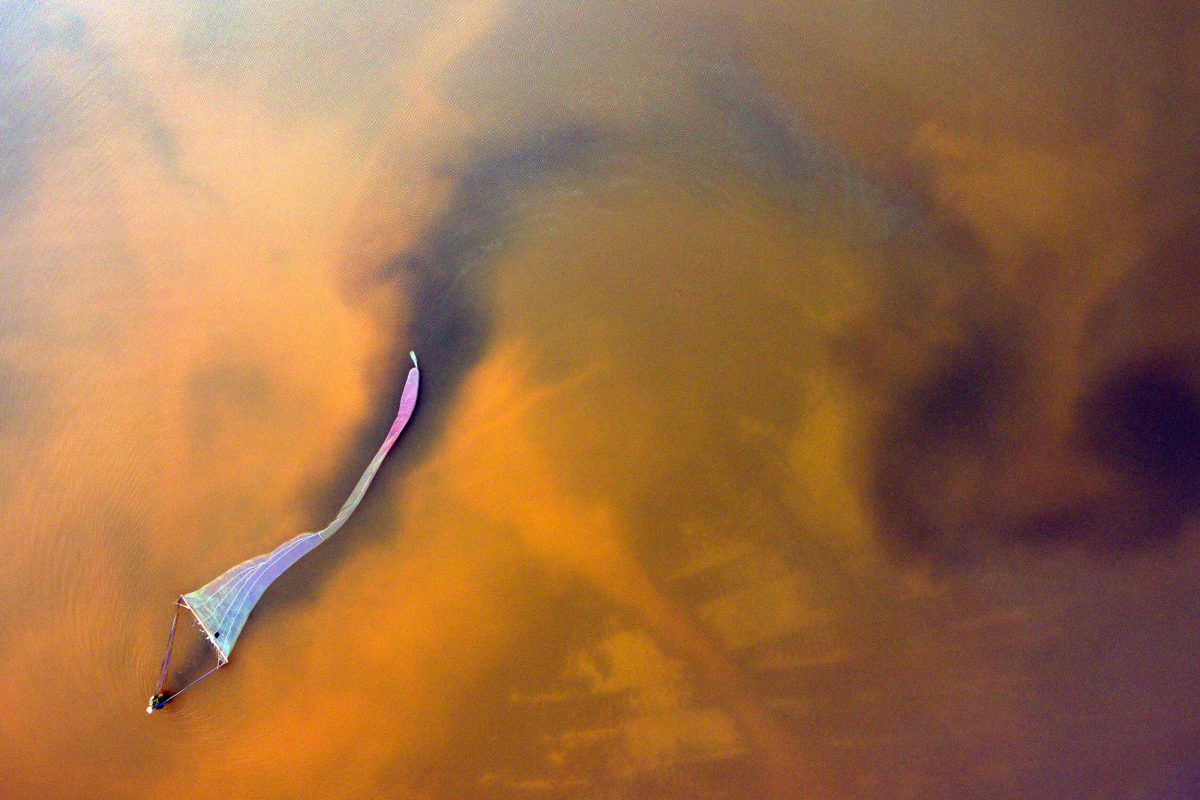
Other countries have jumped on the Artemia feed bandwagon over the years, including China where their salt lake in Yuncheng is regularly harvested. Photo by Imago/Alamy Stock Photo
And still weirder things are ahead for sea monkeys. Patrick Sorgeloos, a renowned aquaculture researcher, originally introduced to Artemia through cancer research in the 1960s, became the brine shrimp’s Johnny Appleseed in the 1970s, ’80s, and ’90s. He has worked tirelessly to propagate them around the world. He consulted on brine shrimp start-up programs in Brazil, the Philippines, and Vietnam and helped begin selective breeding programs to tailor shrimp to different feed needs. He’s even bullish on Artemia as human food. “It turns out to be well suited for infant formula,” Sorgeloos tells me via Zoom from Shanghai, explaining that they can be raised to have the right nutritional profile to rear larval humans. “So it can become even a bigger part of food security.” In this Soylent Green–like future, sweet water lakes might desiccate and turn saline and their fish might perish, but humans could endure, fed on the wriggling micro shrimp that will manage to thrive on a hot, hostile planet.
So if Artemia are eventually fully domesticated, will the economic argument for the lake’s continued existence lose its muscle? As our sampling trip comes to an end, in spite of everything I’ve learned about the lake and the role it plays in global food security, I can’t shake the sense that this quasi-Martian landscape is a hard sell. I worry that the lake is a curiosity at best, whose vanishing would hardly be noticed outside of Utah.
Van Leeuwen would still argue that the lake has incalculable value even if a single Artemia were never harvested. Here, he tells me, there is life, abundant irrepressible life, the kind of life that the original settlers of the basin might have seen; the kind of wild abundance modern humans don’t even know exists. Motoring along toward sampling site 2583 (a site Van Leeuwen finds particularly interesting), he tells me about “Great Salt Lake coral” he helped to discover in the lake, called microbialites—crenulated brain-shaped calcium carbonate structures formed by microbes. Microbialites exist mostly in salt lakes and they play an ecosystem role analogous to that of coral reefs in tropical ocean waters (albeit for far less charismatic creatures). Brine shrimp aggregate around them but, more significantly, microbialites are the primary rearing habitat for brine flies. If it weren’t for microbialites, the great clouds of buzzing, swarming insects that make Great Salt Lake home could wither. As lake levels drop, microbialites are exposed and buffeted by wind and water and soon break apart and perish.
Though high in salinity, the Great Salt Lake is a haven for waterbirds. A geologic feature, microbialites, house microbes and insects, food for birds. Video by thevidsource/Pond5
But who cares about salty globs of bugs and microbes? I think as we head into a cove in the lee of a north wind.
And then suddenly, the reason I should care fills my field of vision. Stretching kilometers all around, waterbirds swarm and dive. Eddies that seem like fish swirls pock the water all around the boat. Grebes. Splashes and boils that resemble tuna or striped bass breaching—still more grebes paddling to the horizon. All in all, somewhere between two and five million of the waterbirds. “Like Woodstock for grebes,” Van Leeuwen jokes. And not only grebes abound here. Great Salt Lake turns out to be a critical stopover on what’s called the Pacific Flyway that connects the Arctic tundra to the wetlands of South America. Were Great Salt Lake and all its brine flies and shrimp to go away, 10 million birds would have to find somewhere else to refuel. And here’s the problem: there is nowhere else.
Quietly, Van Leeuwen echoes my thoughts as I stare out at the vast Escher-esque scene of birds, foam, and water, “Seeing two to five million of anything is overwhelming.”
And then he took in the readings for yet another sample.
“Depth?”
“1.9 meters.”
“Air temp?”
“17 ˚C.”
“Water?”
“12.2 ˚C.”
“Salinity?”
“14.6 percent.”
The quiet, peaceful drone of scientists at work, cataloging the natural world as it disappears around them.
Are all these numbers important? I wonder out loud. Does it all add up to something big enough to make the lake the state’s, and indeed the country’s, priority?
Van Leeuwen ponders this and then answers with a low, slow tone that is nuanced by the thousands of afternoons he’s spent surveying this lake that he loves.
“Does all this data tell a story? Yes, it does. You make models where basically you can see how it runs, like a machine. You can change the parameters and see what happens. And it survives. To a point.” Van Leeuwen has seen this lake nearly disappear. He’s seen it come roaring back. He’s seen the skies blacken with birds fed by its wealth. He knows that the parameters that he carefully monitors comprise a force field that protects the continuation of life itself. With all his hours, days, and years of witness, it seems to him that it must continue.

Millions upon millions of migratory birds rely on the Great Salt Lake as they head to points north or south depending on the time of year. Photo by rollie rodriguez/Alamy Stock Photo
And if it doesn’t? Modelers of humanity predict a 0.2 percent per year risk of our own species’ extinction. Multiplied over 2,000 years, that suggests a 100 percent chance of our end by the mid-4020s. When we vanish, the giant hornet’s nest of problems we created will go away with us and Great Salt Lake may stabilize. Who knows what the lake will look like at that distant time. But one thing is nearly certain. Artemia cysts will surely persist.
If the right conditions come along again, 2,000 years from now, they’ll hatch.

